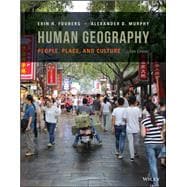Fouberg/Murphy: Human Geography: People, Place, and Culture, 12th Edition, teaches students to appreciate the diversity of people, places, and cultures, and understand the role people play in shaping our world. The goals of this edition are to provide geographic context to global, regional, national, and local issues and to teach students to think geographically and critically about these issues. Human Geography features beautifully designed maps, dozens of vibrant photographs taken by the author team, and author and guest field notes that help students see how geographers read cultural landscapes and use fieldwork to understand places.
Fouberg’s Human Geography, 12th Edition, now integrates Threshold Concepts to help students develop their ability to think geographically. Once they learn and apply one of these concepts in the context of a given place, students integrate it into their thinking and can draw from it as they learn new material and explore other places.









